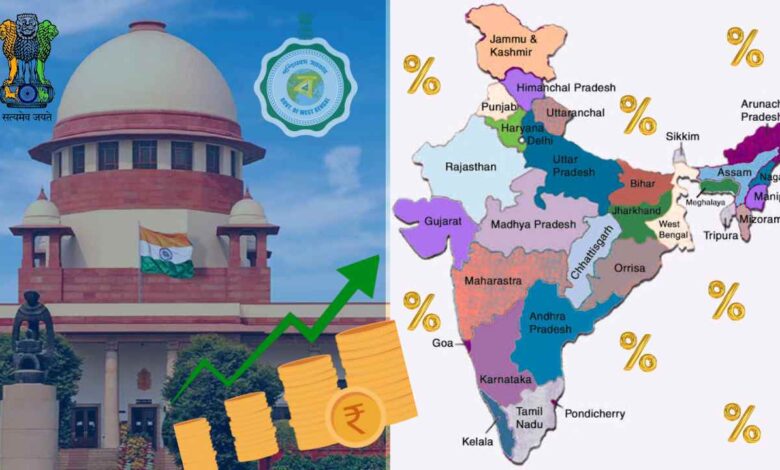A to Z of Dearness Allowance: What is DA, Why is it Given, and What is the Current Rate in All States and UTs? A Complete Analysis

Dearness Allowance (DA) is a very important subject for government employees. This allowance helps to adjust the cost of living in an inflationary market. Recently, after the DA announcements by the central government and various state governments, this matter has once again come into the limelight. Particularly, the recent Supreme Court directive regarding the DA of West Bengal government employees is of special significance. Let’s delve into this matter in detail.
What is Dearness Allowance (DA)? Why is it so important?
Dearness Allowance is a part of the salary or pension of government employees and pensioners. In simple terms, this allowance is given to maintain the purchasing power of employees in line with the rate at which the cost of living increases due to rising inflation. It helps to mitigate the impact of the rising cost of living.
Typically, the central government revises the DA every six months (in January and July) based on the All India Consumer Price Index (AICPI-IW). State governments also usually follow the central government’s lead, but there can be some variations based on the state’s own financial situation and other factors.
Dearness Allowance also plays an important role in boosting employee morale and increasing their commitment to work.
Get Instant News Updates!
Join on TelegramCurrent DA rate for Central Government employees
From January 1st of the current year (2025), the Dearness Allowance for central government employees has been increased by another 2%. As a result, the DA for central employees has increased from 53% to 55%. Millions of employees and pensioners have benefited from this decision of the central government. It is expected that the DA may increase by another 2-3% in July this year, which could be more good news for central government employees.
The West Bengal Context: Tug-of-war over DA and Supreme Court’s directive
For a long time, there has been a difference of opinion and legal battle between the West Bengal state government and employee organizations regarding the Dearness Allowance rate for state government employees. Allegations have repeatedly surfaced that employees in West Bengal are being deprived due to a lower DA rate compared to many other states and the central government.
Current Situation: After the West Bengal government increased the DA for employees by 4% from April 2025, it currently stands at 18%. However, this rate is still significantly lower than the central government’s 55% DA.
Supreme Court’s Intervention: The DA-related case, after going through the Calcutta High Court, finally reached the Supreme Court. On May 16, 2025, the apex court issued an important interim order to the West Bengal government. According to this order, the state government has to pay 25% of the outstanding Dearness Allowance to the employees within the next 6 weeks. The next hearing of this case is scheduled for August. This Supreme Court ruling is being considered a significant step in the long-standing struggle of state government employees and has instilled new hope in their minds.
Dearness Allowance Scenario Across India: Comparative Table of States and Union Territories (May 2025)
Significant differences are observed in Dearness Allowance rates across various states and union territories in India. While some states provide DA at a rate equivalent to the central government, this rate varies in many states. The table below provides a comparative picture of the latest available DA rates (as of May 2025) according to the Seventh Pay Commission (or equivalent latest pay revision) for different states and union territories.
| Sr. No. | State/Union Territory | DA Rate (%) | Effective Date / Remarks |
|---|---|---|---|
| 1 | Himachal Pradesh | 56% | 01.05.2025 (Possible base 53% + 3% increase) |
| 2 | Central Government | 55% | 01.01.2025 (Confirmed) |
| 3 | Arunachal Pradesh | 55% | 01.01.2025 (Confirmed) |
| 4 | Assam | 55% | 01.01.2025 (Confirmed) |
| 5 | Bihar (Seventh Pay Commission) | 55% | 01.01.2025 (Confirmed) |
| 6 | Chandigarh (Union Territory) | 55% | 01.01.2025 (Confirmed, follows Central rate) |
| 7 | Chhattisgarh | 55% | 01.01.2025 (Confirmed for Electricity Board; probable for other employees, follows Central rate) |
| 8 | Delhi (NCT) (Union Territory) | 55% | 01.01.2025 (Confirmed, follows Central rate) |
| 9 | Gujarat | 55% | 01.01.2025 (Confirmed, 53% + 2% increase) |
| 10 | Haryana | 55% | 01.01.2025 (Confirmed) |
| 11 | Jharkhand (Seventh Pay Commission) | 55% | 01.01.2025 (Confirmed) |
| 12 | Madhya Pradesh | 55% | 01.01.2025 (Confirmed) |
| 13 | Nagaland (ROP 2017) | 55% | 01.01.2025 (Confirmed) |
| 14 | Odisha | 55% | 01.01.2025 (Confirmed) |
| 15 | Puducherry (Union Territory) | 55% | 01.01.2025 (Confirmed) |
| 16 | Rajasthan | 55% | 01.01.2025 (Confirmed) |
| 17 | Tamil Nadu | 55% | 01.04.2025 (Possible base 53% + 2% increase) |
| 18 | Uttar Pradesh | 55% | 01.01.2025 (Confirmed) |
| 19 | Uttarakhand | 55% | 01.01.2025 (Confirmed) |
| 20 | Andaman & Nicobar Islands (UT) | 55% | 01.01.2025 (Probable, follows Central rate) |
| 21 | Dadra & Nagar Haveli and Daman & Diu (UT) | 55% | 01.01.2025 (Probable, follows Central rate) |
| 22 | Lakshadweep (Union Territory) | 55% | 01.01.2025 (Probable, follows Central rate) |
| 23 | Jammu & Kashmir (Union Territory) | 53% | 01.07.2024 (Seventh Pay Commission) |
| 24 | Ladakh (Union Territory) | 53% | 01.07.2024 (Seventh Pay Commission, follows Jammu & Kashmir) |
| 25 | Sikkim | 53% | 01.07.2024 |
| 26 | Meghalaya | 49% | 01.01.2025 |
| 27 | Punjab | 42% | 01.11.2024 |
| 28 | Mizoram | 40% | 01.11.2024 |
| 29 | Manipur | 39% | 01.01.2025 |
| 30 | Andhra Pradesh (RPS 2022) | 33.67% | 01.07.2023 (Cash from 01.04.2024) |
| 31 | Telangana (RPS 2022) | 33.67% | 01.07.2023 (Cash from 01.07.2024) |
| 32 | Tripura | 33% | 01.04.2025 |
| 33 | West Bengal | 18% | 01.04.2025 (Supreme Court interim order for pending DA payment exists) |
| 34 | Kerala (Eleventh PRC) | 15% | 01.04.2025 |
| 35 | Karnataka (Seventh State Pay Commission) | 10.75% | 01.07.2024 (2024 Revised State Pay Structure) |
| 36 | Goa | 55% | 01.01.2025 |
| 37 | Maharashtra | 455% | For Fifth Pay Commission employees from 01.07.2024 |
Note: The information provided in this table has been compiled based on the latest available government notifications, reliable news reports, and other sources. The Dearness Allowance rate is a dynamic subject, and state governments may make new announcements at different times.
Overall, Dearness Allowance is an essential component of the financial security of government employees. The recent steps taken by the central government and various state governments in this regard are undoubtedly a relief for the employees. In the case of West Bengal, the Supreme Court’s directive has opened a new horizon, which millions of state government employees are looking towards. It is everyone’s expectation that more positive steps will be taken regarding Dearness Allowance in the coming days. The role of DA in improving the living standards of government employees and combating inflation is undeniable.

